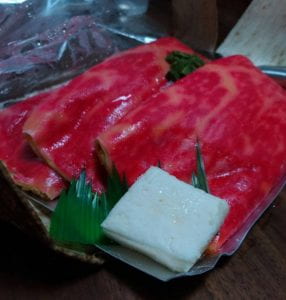このクラスでは、できるだけ自然な話し方を練習するためによく使うけど教科書にはないこともたくさん練習しました。例えば「はっくしょん」とか「あ、びっくりした!」などです。そんな中、どこで役に立つかわからないことも勉強しちゃいました。「髪の毛」「あごひげ」「口ひげ」、その上なぜか「耳毛」「鼻毛」まで教えてから、学生と「どこで使うんだろう?」とちょっと考えました。そこで、次の日の朝「あ、もっと使える言葉があった」と思って「まゆげ」と「まつげ」を教えました。「テストに出しましょうか」と聞いたけど、「それはちょっと…」と言われてしまいました。
これは肉みたいなケーキなんですよ。「あ、びっくりした!」
In this class, we practiced a lot of common expressions that are not necessarily found in the textbook. For example, hakkushon (how to sneeze in Japanese) and a, bikkuri shita (how shocking), etc. While practicing these Japanesey expressions, we to our horror and sorrow (!) studied some expressions no one knows whether we’d ever have to use. We covered ‘hair on the head’, ‘beard’, ‘moustache’, followed by (for some reason), ‘hair in the ears’ and ‘hair in the nose’. The next morning, it occurred to me “there are far more useful words” and taught ‘eye brows’ and ‘eye lashes’. I asked the students “should I put these words on the test?” but they politely refused — yes, politely…
By the way, you’ll see above a picture of a cake that looks like meat. Now you can say in Japanese, “Ah, bikkuri shita (I’m surprised)!”

